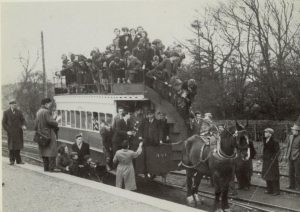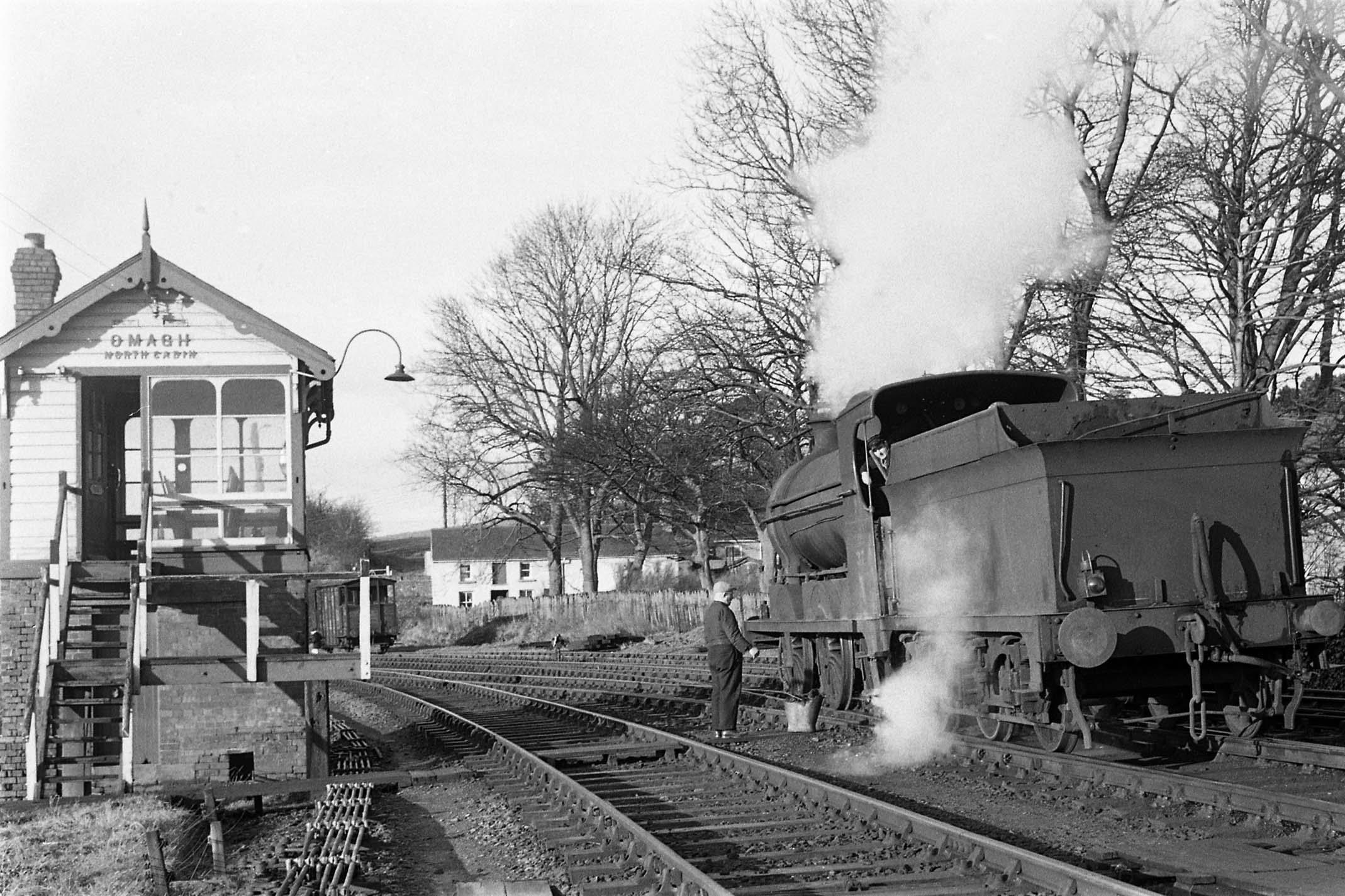Today marks the 60th anniversary of the closure of Omagh Railway Station, writes Steve Bradley. Yet for almost 120 years Tyrone stood at the heart of an extensive rail network across west Ulster. The county contained a number of mainline and branch-line services on standard and narrow gauge tracks – and famously even a horse-drawn tram. The most successful of these was the famous ‘Derry Road’ route which traversed the county on its way between Derry and Portadown. These lines and services were all initially established and operated by an array of private companies, but the 1948 Transport Act nationalised all rail and bus services across Northern Ireland under the control of the newly established Ulster Transport Authority. It was a move that would lead to the decimation of Tyrone’s entire rail infrastructure in the two decades that followed.
The ‘Derry Road’ (1861-1965 – Standard Gauge)
IRELAND’S first railway opened in Dublin in 1834, and in 1836 the Ulster Railway Company was formed to expand rail across the north of the island. It began with seven miles of track from Belfast to Lisburn in 1839 before reaching Portadown in 1842. In 1855 the ‘Portadown, Dungannon and Omagh Junction Railway’ (PD&O line) was established to connect those three towns – reaching Dungannon in 1858 and Omagh by 1861. There the new line formed a junction with the Derry and Enniskillen Railway route, which enabled trains to travel from Derry to Portadown for the first time – on what was to become affectionately known as ‘The Derry Road’. Tyrone’s long love affair with rail had well and truly begun.
The ‘Derry Road’ ran south from Derry along the Donegal side of the Foyle Valley before crossing over to Strabane. From there it continued to Omagh (via Sion Mills, Victoria Bridge and Newtownstewart), Dungannon (via Carrickmore and Pomeroy) and Portadown, where services continued to Belfast or Dublin. The line was an instant commercial success and helped stimulate significant economy activity along its route – becoming the most important rail route in Ulster for more than a century.
The first blow to its fortunes came in the 1920s, however, when the arrival of motorised road vehicles combined with the global economic depression to severely impact passenger and freight demand. The Second World War provided a temporary boost, with the line used to ferry troops and munitions (and for cross-border smuggling by civilians). But the end of the war saw the old challenges return and amplify, made worse by the roads-focus of the new Ulster Transport Authority (UTA). It closed a series of rail lines across the west of NI in the 1950s, leaving the Derry Road increasingly isolated. Stormont then commissioned the Benson Report into the future of rail in NI, and when published in 1962 it recommended mothballing the Derry-Portadown line. The UTA was only too happy to oblige. As this was the last remaining piece of rail anywhere in Tyrone, when the line carried its last train on St Valentine’s Day in 1965 it marked the end of the county’s 120 year love affair with rail. To prevent any chance of the line making a future comeback, the UTA had lifted and scrapped all the track and sold all the land by early 1967. And so began Tyrone’s ongoing decades of isolation from the island’s rail network.

Derry & Enniskillen Railway (1847-1957 – Standard Gauge)
THE first part of this line ran between the Cityside of Derry and Strabane, and was opened in 1847 – making it the first rail route anywhere in Tyrone. It continued southwards to Fintona via Omagh in 1853, before finally reaching Enniskillen in 1854. After the Great Northern Rail company was formed in 1876, the section of this line north of Omagh became part of the ‘Derry Road’ route. The section between Omagh and Enniskillen was downgraded to a secondary route, and eventually closed by Stormont in 1957.
Cookstown Stations (1856-1859 – Standard Gauge)
IN 1879 the Great Northern Railway (GNR – which operated the Derry Road) turned its attention to Mid-Ulster by opening a branch line from Dungannon to Cookstown (via Coalisland and Stewartstown). It wasn’t the first rail route in that part of the county, however, as the Belfast and Ballymena Railway had opened a branch line to Cookstown as early as 1856. That route ran south from Randalstown, Magherafelt and Moneymore to a terminus on Cookstown’s Moleworth Street. When the GNR reached the town 23 years later they located their terminus right next door to it – though the two lines were never connected for passenger services. Passenger services at the GNR Cookstown station ended in 1956, with freight services running for another three years. The station survives to this day as the home of Cookstown Hockey Club.
Castlederg and Victoria Bridge Tramway (1883-1933 – Narrow Gauge)
TYRONE’S first narrow gauge service was the Castlederg and Victoria Bridge Tramway, which opened in 1883. It ran for seven miles from Castlederg through Spamount, Crew and Fyfin to Victoria Bridge, where there was a junction with the mainline GNR ‘Derry Road’. The Tramway operated successfully until hitting hard times in the 1920s. On the verge of bankruptcy in 1933, the company took advantage of an NI-wide rail strike to shut the business for good. The old station in Castlederg remains standing to this day, beside Lecky’s convenience store on Upper Strabane Road.
Clogher Valley Railway (1887-1942 – Narrow Gauge)
THE Clogher Valley Railway opened in 1887 and ran from Maguiresbridge in Fermanagh to Tynan in Armagh, via a route which included Fivemiletown, Clogher, Augher, Ballgawley and Aughnacloy. Originally called a Tramway, for almost all of its length the service ran alongside the public highway. The rural nature of the area it served meant that the line struggled financially. Local ratepayers became saddled with covering the costs of keeping it open, before wartime cuts saw it closed by Stormont in 1942.
Londonderry and Strabane Railway (1900-1955 – Narrow Gauge)
THE Co Donegal Railway operated 75 miles of narrow gauge rail from the cityside of Derry right into Donegal – but all the rail routes that brought freight to Strabane were standard gauge. This increased the costs and time the company faced in transferring goods between the two systems. It therefore decided to open its own narrow gauge route between Derry and Strabane, travelling via Donemana and Ballymagorry. That line opened in 1900 and remained operational until 1954 for passengers and 1955 for freight – at which stage the UTA axe swung closed it on the basis that it duplicated part of the Derry Road route.
Strabane and Letterkenny Railway (1909-1960 – Narrow Gauge)
THE Co Donegal Railway opened a 19 mile narrow gauge route between Strabane and Letterkenny in 1909. Strabane served as both the line’s headquarters and its only station in Tyrone – with the rest of the route running through Lifford, Raphoe, Convoy and Letterkenny. The line was heavily focused on freight traffic, and remained in operation until 1960.
Fintona Horse-drawn Tram (1856-1957)
WHEN the rail line between Omagh and Enniskillen was built, a mainline station was opened in Fintona in 1853. It lasted for three years until the continuation of the line onwards to Enniskillen saw services moved from Fintona to a new Fintona Junction station instead. That left a short branch line intact between Fintona and Fintona Junction, upon which a horse-drawn tram car was famously used to ferry passengers for the ten minute connection. The tram car remained in operation until 1957, and every horse used to pull it over the years was called ‘Dick’.







